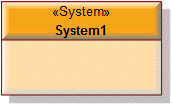• From a
System: right-click the System, point to New, point to DoDAF, point to System, and then click System.
You can convert a System to a
Software: right-click the System, point to Convert To, and then click Software.
The following sections provide information about how a System is used in the model.
In addition to the UPDM elements that can be created from all UPDM elements (
Representation,
Definition,
Information, and
Metadata):
In addition to the
AV-2 Integrated Dictionary and
StdV-1 Standards Profile, which can show all UPDM elements:
The following writeable properties are available on the System tab of a System element's Property Pages:


 System toolbar button, and then click in free space on the diagram.
System toolbar button, and then click in free space on the diagram.
